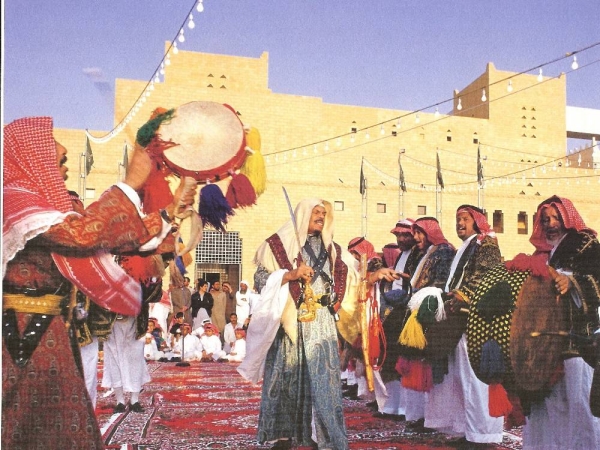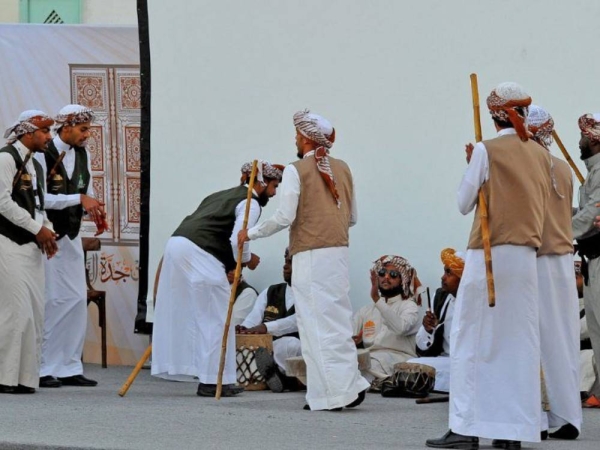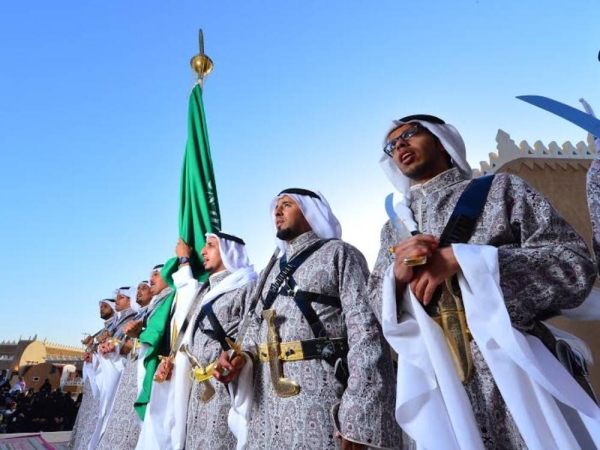














Traditional dances in the Kingdom of Saudi Arabia, or folk dances, are artistic performances and cultural heritage within local communities in Saudi Arabia. The most renowned of these dances is al-Ardah, recognized as an iconic dance and the first Saudi element to be included in the United Nations Educational, Scientific and Cultural Organization (UNESCO)'s list of intangible heritage. Originally performed in preparation for war, it later evolved into an expressive manifestation of joy and an official celebration for leaders of nations. The dance commences with the traditional al-Hawrabah call.
The origins of traditional dances in Saudi Arabia
Most traditional Saudi dances originated during military events. They were first performed during military marches or as part of war songs, or gained popularity during the war. The most famous war songs are Najd Shamat, as well as al-Dahha al-Shamaliya, the Hijazi Taasheer, and al-Khutwa al-Aseeriya or al-Janoubiya.
Traditional dances are perceived as cultural heritage that cannot be altered, yet they have evolved due to various political boundaries. Some dances exhibit similarities or even identical performances in neighboring countries, occasionally sharing the same names or music for these dances.
Saudi al-Ardah
Saudi al-Ardah, locally referred to as al-Ardah al-Najdiyah, is the icon of traditional Saudi dances. It serves as the official ceremonial protocol for welcoming visiting heads of state to Saudi Arabia. Inscribed in 2015, al-Ardah is the first Saudi element to be included on UNESCO's Representative List of Intangible Heritage.
It was previously performed in preparation for the war, aiming to familiarize the army with the conditions of the battles. It later evolved into an expressive manifestation of joy. It is performed collectively, commencing with al-Hawrabah (the call to start al-Ardah). The dance starts with an enthusiastic performance, synchronizing between al-Takhmir (beating the drum twice), al-Tathlith (beating the drums thrice), and a special poem called al-Harbi. Participating performers carry a flag and swords and wear the same uniform. Finally, the dance concludes with al-Zamyia (a hymn entitled "Tahta Bayraq Sayidi Sama’an Wa Ta'a" (By Your Command).
Al-Dahha al-Shamaliya
The traditional al-Dahha al-Shamaliyasong incorporates sharp sounds produced by the performers, symbolizing readiness for battle or the demonstration of unusual combat skills, akin in resonance to the roar of a lion. This song's success relies on the potency of human voices, referencing age-old rituals of vocal preparation for warfare. Moreover, al-Dahha song serves as a ceremonial ode to the triumph of warriors and their jubilation following the conclusion of the battle. Much like the traditional dances in Saudi Arabia, al-Dahha is performed by a line of performers, who face a performer constantly maneuvering among them while adorned with the Mishlah, a pivotal element in performing this maneuver.
Navigation songs
Saudi Arabia's Eastern Province is home to traditional dances similar to those of the GCC countries. A vast musical repository of marine navigation songs emerged along that coastline, comprising a list of songs associated with pearl divers.
The art of Fajri is one of the most famous traditional dances in al-Ahsa Governorate. Its name originated from one of the eight styles of this dance known as al-Hasawi. This performance relies on a lead singer supported by a group of clappers and other singers. On the other hand, the group depends for its performance on a two-sided hand drum, known as mirwas, and a clay pot played with both hands, known as Jahila. The name of this dance, Fajri, was inspired by a musical instrument called al-Fujayri, which consisted of clay pots. When the performers tapped with their hands on the outer body of this instrument, it produced loud sounds.
Hijazi Taasheer
Among most of the traditional dances in Saudi Arabia, Hijazi Taasheer is often recognized as a weapon dance rather than a war dance, as it depends on the skills of using a rifle. Taasheer is traditionally performed to simulate, recall, or act out the fight or the fighting moves as a performance. This dance is usually performed for ceremonial purposes. The main feature of Taasheer is jumping over the projectile of a rifle. The performer goes through two steps to successfully execute the dance. First, the performer holds the rifle horizontally with both hands and throws it up to pick it up again. In the second stage, the gun's muzzle is turned downward, then the performer fires at the ground and jumps simultaneously to avoid injury. Taasheer is a sport that requires agility and entertainingly combines mental and physical coordination.
Al-Khutwa al-Aseeriya
Al-Khutwa al-Aseeriya or al-Janoubiya is the most common dance in the southern regions of Saudi Arabia. The choreography of this dance reflects its name, as it requires making one step forward and then stepping backward in a rhythmic beat while performers form a row. Al-Azzawi dance in Jazan shares similarities with al-Khutwa al-Aseeriya, but it involves shorter steps that do not extend beyond the standing position, and they are executed more frequently.
Al-Qazoui is the local dance that requires the most shifting of body positions. The performer shifts his weight by bending to the middle, then returns to an upright position, and jumps after taking about four steps. The success of al-Qazoui performance lies in taking five rhythmic beats to transition into a new sequence of steps.
Characteristics of the traditional dances in Saudi Arabia
Dances in some of Saudi Arabia's regions are characterized by their own unique features. For example, the southern region is known for executing al-Khutwa as the main pattern of the dance in the southern regions of Saudi Arabia. On the other hand, the Saab dance is exclusive to Najran Province, in which a dual is executed between two performers, while one carries a dagger and the other a cane.
Despite the diversity of the dances from one region to another, the basic steps and the dance styles are similar, especially among the dances of the neighboring regions, which sometimes share similar features. Moreover, most traditional dances across Saudi Arabia's provinces require performers to stand in opposing rows on the dance floor, while striking their feet and carrying a particular tool like a cane, sword, or dagger. The differences between these dances usually lie in the movement and vocal responses of the two rows.
Related quizzes
Related articles

